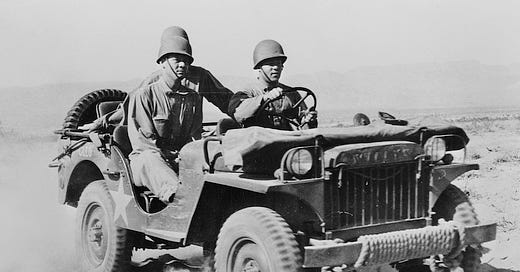The US Army Infantry Battalion of April 1942
Battalion: An Organizational Study of United States Infantry
Welcome to the Tactical Notebook, where you will find five hundred or so tales of armies that are, armies that were, and armies that might have been. If you like what you see here, please share this article with your friends.
The estate of the late John Sayen has graciously given permission to the Tactical Notebook to serialize his study of the organizational evolution of American infantry battalions. The author’s preface, as well as previously posted parts of this book, may be found via the following links:
In April of 1942, the US Army adopted new tables of organization for infantry battalions. These eliminated the auto-rifle squad that had previously been located in each rifle platoon, transferred the anti-tank platoon from the weapons company of each battalion to the battalion headquarters company, and added a two-squad section to each the 81mm mortar platoon. The new tables also replaced the 1/2-ton trucks authorized by older establishments with a mixture of 1/4-ton and 3/4-ton trucks.
The Browning Automatic Rifles (BARs) made redundant by the elimination of the auto-rifle squads were issued, at a rate of one per squad, to the three rifle squads of each platoon. To accommodate these weapons, one rifleman in each squad became the auto-rifleman, another became the assistant auto-rifleman, and the third was designated as the ammunition carrier for the BAR. (The assistant BAR man and the ammunition carrier retained their M-1 rifles.)
As had been the case with the tables adopted in December of 1940, each rifle squad consisted of twelve men. One, the aforementioned auto-rifleman, carried a BAR. Another, the rifle grenadier, carried an M-1903 Springfield rifle fitted with a grenade-launcher. Of the rest, all ten carried M-1 rifles. (Once suitable grenade-launchers became available, the rifle grenadiers replaced their Springfields with M-1 rifles.)
The two changes to the weapons company deprived the structure of that organization of the symmetry it had previously enjoyed. What had been a “square” unit of four four-squad platoons became a triangular organization with a big mortar platoon and two small machine gun platoons.
All of the squads of the weapons company were formed into two-squad sections. Within each section, one of the two 3/4-ton trucks was supplied with a BAR. This served both as the personal weapon of the driver and a means of anti-aircraft defense. (The other driver in each section carried an M-1 rifle.)
The leaders of the machine gun and mortar squads of the weapons company bore Springfield rifles fitted with grenade launchers. As these were able to fire the hollow-charge anti-tank grenades, these provided the weapons company with a degree of protection against light tanks and armored cars.
The provision of a third section to the 81mm mortar platoon made possible the attachment of a two-squad mortar section to each of the three rifle companies of an infantry battalion. It also facilitated “advance by echelon.” (This was a technique in which two sections remained ready to fire while the third moved from one firing position to another.)
Strange to say, the organization of the 81mm mortar platoon made no provision for the massing of the fires of all six mortars on a single target. Instead, each section possessed a single observer, to whom it was connected by a single telephone line. (When the battalion communications platoon provided a single radio set, it was used to communicate with the headquarters of the weapons company. When, as was rarely the case, two sets were available, they could be used to connect a forward observer to his section.)
The tables of organization of April 1942 expanded the headquarters detachment of each infantry battalion into a headquarters company. This involved the expansion of the old communications section into a communications platoon, the enlargement of the old pioneer section (thereby making a “ammunition and pioneer platoon”), and the transformation of the old intelligence section into a somewhat larger headquarters section. The new headquarters company also provided a home for the anti-tank platoon.
In the course of its transfer from the weapons company to the headquarters company, the anti-tank platoon traded its .50 caliber machine guns for four 37mm anti-tank guns. (The anti-tank platoon rated two jeeps for each of its anti-tank guns, one to pull the gun and the other to carry ammunition.)
Sources:
US Army Adjutant General Table of Organization T/O 7-16 “Headquarters and Headquarters Company, Infantry Battalion” (1 April 1942)
US Army Adjutant General Table of Organization T/O 7-17 “Rifle Company, Infantry Battalion” (1 April 1942)
US Army Adjutant General Table of Organization T/O 7-18 “Infantry Heavy Weapons Company ” (1 April 1942)








